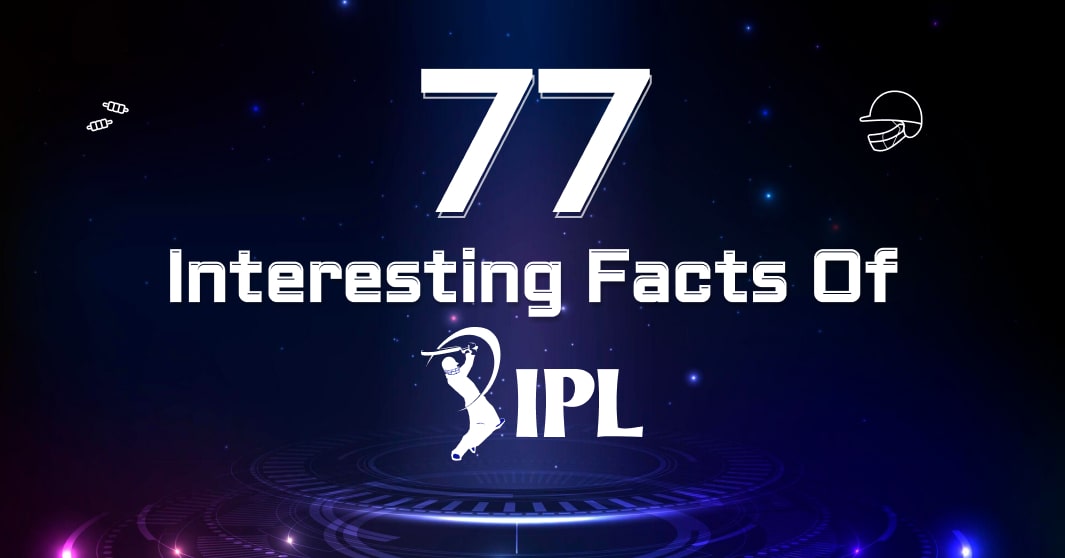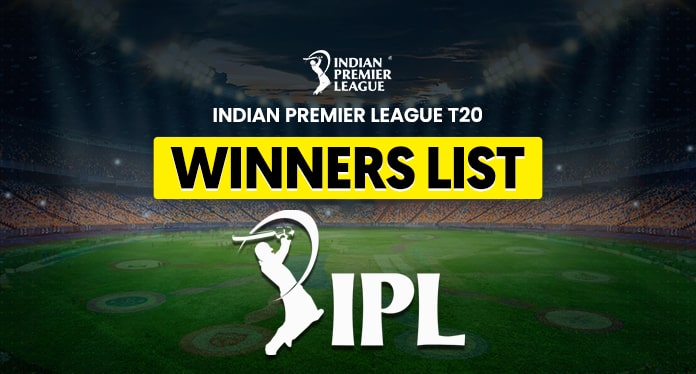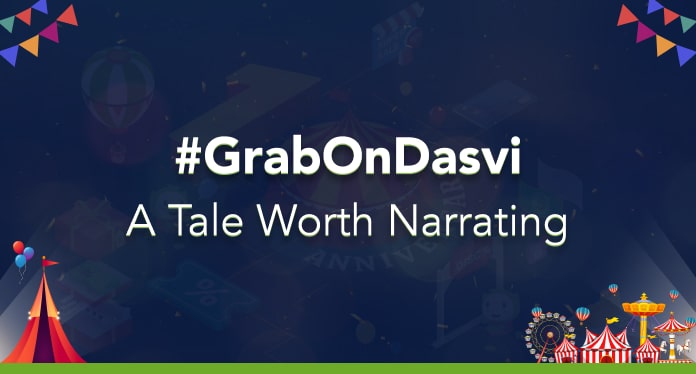After nearly two centuries under colonial rule, the country finally achieved independence in 1947. This year, we celebrate 79 years of freedom, a period in which India has grown to become the world’s fourth-largest economy, even surpassing the United Kingdom, our former colonizer.
This transformation is the result of decisive leadership. Since independence, 14 Prime Ministers have guided India through crucial turning points, from Jawaharlal Nehru’s vision of a modern, industrialized nation to Narendra Modi’s sweeping reforms. Modi now stands as India’s longest-serving Prime Minister, with over 4,078 consecutive days in office, narrowly surpassing Indira Gandhi’s 4,077-day tenure.
In this post, we revisit some of the most historic decisions taken by these leaders — choices that shaped India’s economy, society, and global standing.
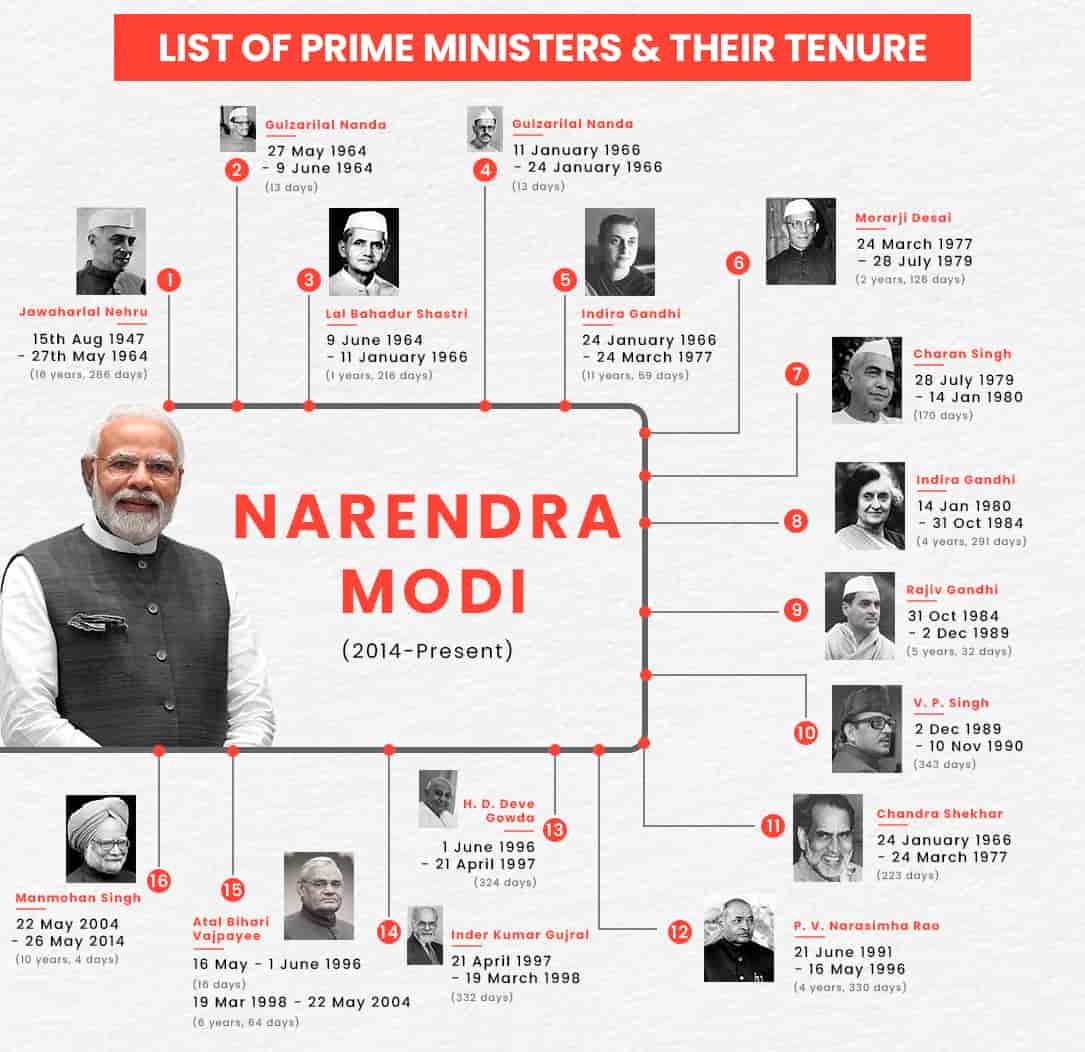
All these achievements would not be possible without the steps and decisions taken by our past and current leaders. We at GrabOn decided to list out the leaders of our great nation and their achievements during their tenure in office. This Independence Day, don’t just know the leaders of the nation. Also, know what they did for the country. Their achievements, welfare schemes, their bold moves, etc, are something you shouldn’t miss! Read further…
Narendra Modi
Tenure: 26th May 2014- Present
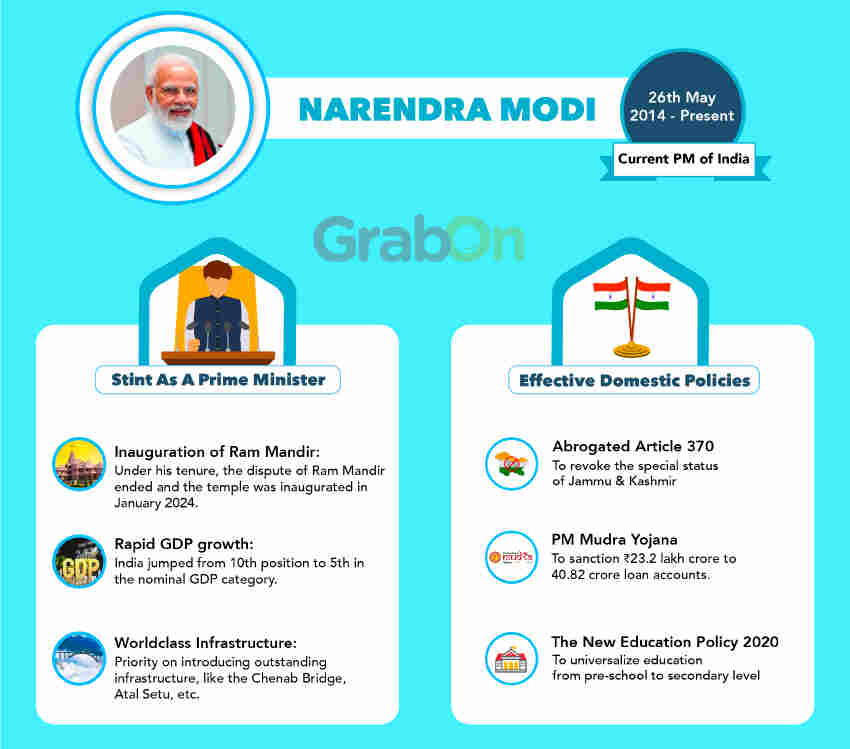
About Narendra Modi
Narendra Damodardas Modi has become the most popular Prime Minister of India since he was elected as the 14th Prime Minister. He became the longest running Prime Minister in the country’s history, holding the office for over 4,078 consecutive days. This popularity is attributed to his personality, schemes, and economic reforms, which have contributed to our country becoming one of the most influential nations globally. After he was elected as the prime minister, he took various bold decisions, like the abrogation of Article 370 from Jammu & Kashmir, the Triple Talaq Bill 2019, the PM Gati Shakti Master Plan, the New Education Policy (NEP 2020), Operation Sindoor and Operation Mahadev against Pakistan’s terrorists after the infamous Pahalgam Terrorist Attack 2025.
And, if we look at India’s foreign policies during Narendra Modi’s tenure, it is straightforward and firm. The best thing about foreign affairs is that he chose some of the best minds, like our Foreign Minister, S. Jaishankar. His presence of mind and deep knowledge about foreign relations helped India maintain a neutral stand during various world conflicts, like the Russia-Ukraine war, the Israel-Hamas conflict, the Israel-Iran conflict, etc. Our relations with China are also improving, which will be great for the region.
Apart from the foreign policy, during the tenure of Narendra Modi, we have seen tremendous growth in our exports. Recently, in July 2025, the Indian government signed a Free Trade Agreement with the United Kingdom. We are also negotiating a trade deal with the United States. This played an important role in the growth of India’s GDP, and today we stand as the fourth-largest economy globally. And, our country did this by surpassing the UK, which once ruled over us for 200 years.
In the past 11 years, Indian Railways has made huge progress in electrifying the railway tracks. Till June 2025, it has electrified up to 99% of the tracks. Narendra Modi’s government has put infrastructure growth on its priorities. In 2025, the Indian Government inaugurated the famous Chenab Bridge in Jammu & Kashmir. This will connect the union territory with the mainland India. In addition to these projects, the Indian Railways is also working on multiple other projects across the country.
Place of Birth: Vadnagar, Gujarat
Qualification: Bachelor of Arts in Political Science, School of Open Learning at the University of Delhi
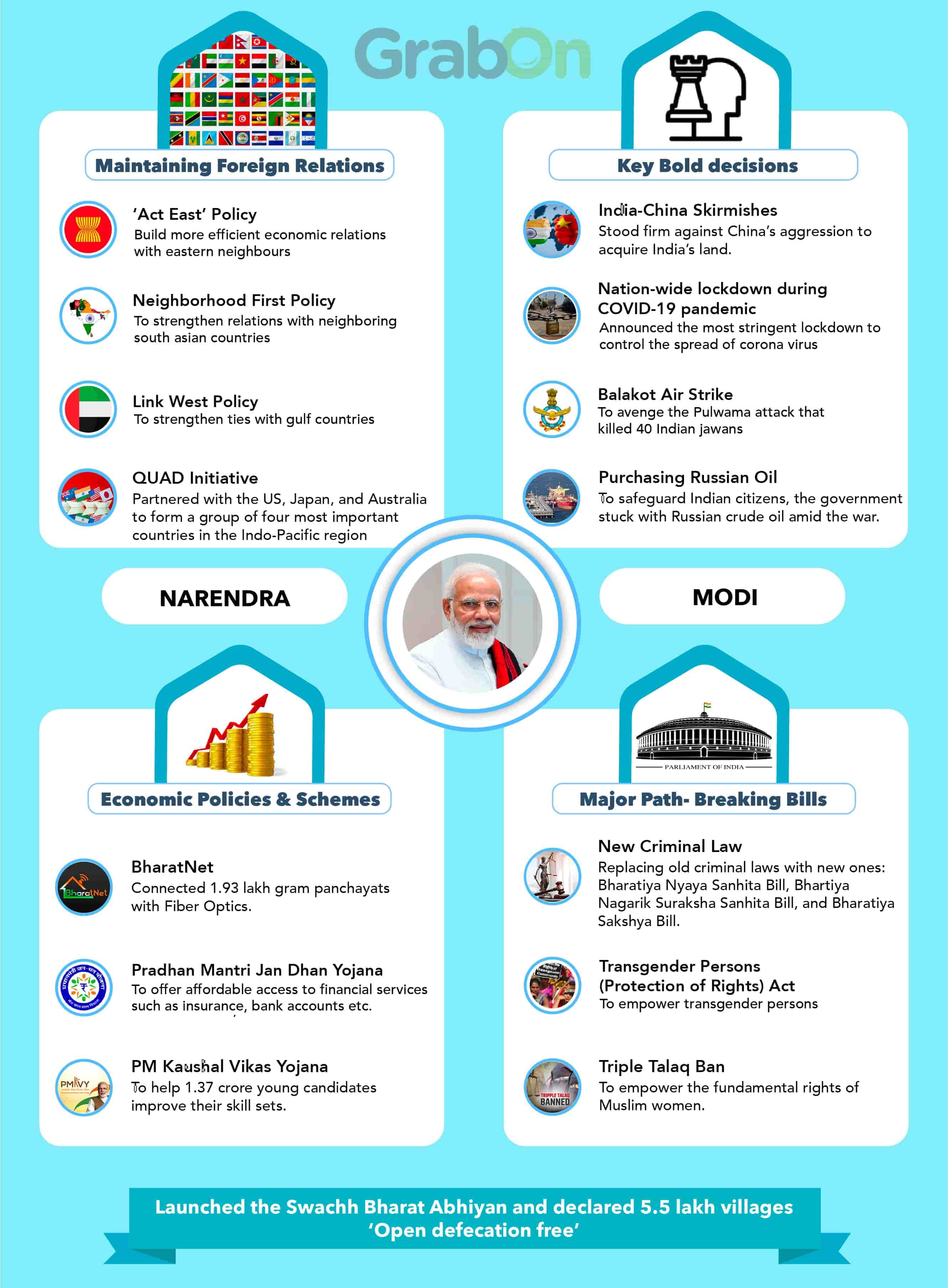
He sits on a list of achievements, including:
- Signed the historic UK‑India Free Trade Agreement in July 2025. This means 99% of Indian exports to the UK will become tariff-free.
- Inaugurated 103 redeveloped railway stations across 18 states under the Amrit Bharat Station Scheme. The project cost was around ₹1,100 crore, and the government has plans to redevelop 1,275 stations.
- Started multiple infrastructure projects in Tamil Nadu worth ₹4,900 crore.
- Launched Operation Sindoor and Operation Mahadev to destroy terrorist camps in Pakistan and those who conducted the Pahalgam Attack.
- India surpassed Japan to become the 4th largest economy worldwide in 2025. Our nominal GDP is around $4.19 trillion and PPP GDP is around $21.875 trillion, which is third in the world.
- Inaugurated the world’s highest railway bridge, Chenab Bridge, which is 321 meters tall.
- Inaugurated India’s longest sea bridge, Atal Setu, which has a length of 21.8 km, out of which 16.5 km is a sea link.
- The 5G network in India was launched on October 1, 2022, and within 36 months, its implementation has crossed 4.69 lakh sites across the country, covering 99.6% the country’s districts.
- Introduced 3 new bills to replace the Indian Penal Code, Criminal Procedure Code, and Indian Evidence Act, with the Bharatiya Nyaya Sanhita Bill, Bharatiya Nagarik Suraksha Sanhita Bill, and Bharatiya Sakshya Bill, respectively.
- With the success of Chandrayaan-3, India became the first country in the world to successfully make a soft landing on the South Pole of the Moon.
- India became the President of G20 in 2023, and the 18th G20 Summit was held at Bharat Mandapam on the 9th and 10th September 2023.
- An increment in the Global Innovation Index of India from 81st rank in 2014 to 39th in 2024.
- Introduced UPI in various foreign countries, like Bhutan, Nepal, Oman, UAE, Southeast Asian countries, the UK, France, etc.
- Inauguration of the new Parliament Building of India, which is laced with some advanced technologies and is earthquake-proof. This building is a part of the Central Vista Redevelopment Project.
- PM Kisan scheme to benefit over 14.5 crore farmers.
- Announced a Rs. 20 lakh crore relief package to make the country self-reliant during the COVID-19 pandemic.
- Introduced the new National Education Policy (NEP) of India in 2020. This policy comes with the 5+3+3+4 education system.
- Electrified 18,000 plus villages across the country in 988 days of the total 1000 days promised during the I-Day speech in 2015. All these villages were dark even after 70-plus years of India receiving its Independence.
- The Beti Bachao Beti Padhao movement aims to promote girls’ education.
- Launched the Pradhan Mantri Ujjwala Yojana to offer cooking gas connections for free to all the poor in society.
- Modi introduced some path-breaking initiatives, of which E-Nam and Soil Health Cards were a hit.
- He also fulfilled one of his biggest poll promises of launching a new Jal Shakti Ministry that addresses all aspects in regard to water resources.
- The mass moment, the ‘Swachh Bharat Mission’ witnessed massive participation with several UTs, and States becoming Open Defecation Free (ODF). The extent of sanitation touched 99% from 38%.
- Make in India and Digital India campaign to improve the country’s online infrastructure and make India a global manufacturing leader.
- Started Ayushman Bharat to provide free medical treatment to the targeted sections.
- Introduced Rs. 25,000 crore worth of special funds to complete housing projects for the middle class.
- Provided 10% reservation to economically weaker sections.
Dr Manmohan Singh
Tenure: 22nd May 2004- 26th May 2014

About Manmohan Singh
Considered to be India’s best Finance Minister, Dr Manmohan Singh is considered to be one of the best economists in the country. He joined the Indian government an Economic Advisor in the Ministry of Commerce. He also held various portfolios such as Advisor to the Prime Minister, Deputy Chairman of the Planning Commission and Governor of the Reserve Bank of India. As the Prime Minister of the country, he was in charge of some of the biggest changes in the country.
Place of birth: Gah, Pakistan
Qualification: Bachelor’s and Master’s in Economics
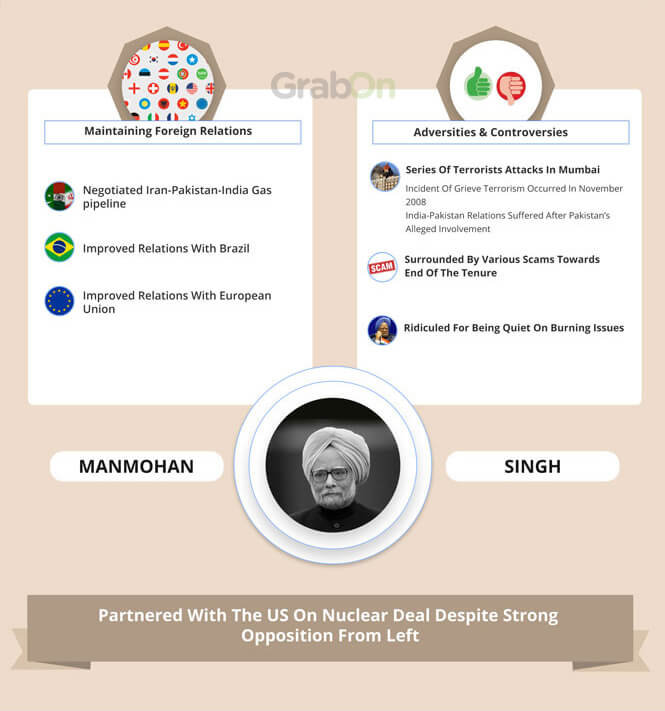
His wonderful achievements include:
-
Fastest Growth & Poverty Drop
GDP growth averaged 8%; poverty fell from 37% to 22%. 180M people exited poverty.
-
MGNREGA Launch
World’s largest rural employment scheme; over 2B person-days of work annually.
-
RTI Act (2005)
Empowered citizens to file 4-5M requests/year, unearthing scams and boosting transparency.
-
US-India Nuclear Deal
NSG waiver ended nuclear isolation, enabling global civil nuclear trade.
Inder Kumar Gujral
Tenure: 21st April 1997- 19th March 1998

About Inder Kumar Gujral
Famous for implementing the Gujral Doctrine, Mr. I.K Gujral was also in office for 10 months. Mr. I.K Gujral held important positions including Minister of External Affairs, Water Resources Minister and Minister of Information and Broadcasting before handling the PM office. Gujral was also a part of India’s freedom struggle and was jailed for taking part in the Quit India Movement.
Place of Birth: Jhelum, Pakistan
Qualification: Bachelor of Commerce, Punjab University
Below are some of his major achievements:
-
Gujral Doctrine
No-reciprocity approach to South Asia. Signed the Ganga Treaty with Bangladesh.
-
Media Freedom
Enabled private FM radio and repealed restrictive press proposals.
Haradanahalli Doddegowda Deve Gowda
Tenure: 1st June 1996- 21st April 1997

About Haradanahalli Doddegowda
Holding the post for 10 months, Mr Gowda was also the head of the United Front Government. In these 10 months of tenure, he was also the Chairman of the Steering Committee of the United Front. This was the highest body which was in charge of all the constituents of the ruling front. During his tenure as the Chief Minister of Karnataka, he successfully led the government by tackling many issues.
Place of Birth: Haradanahalli, Karnataka
Qualification: Diploma in civil engineering from L. V. Polytechnic
Here are some of his key achievements:
-
Reform Continuity
GDP grew 7.8%; Dream Budget slashed tax rates. FDI and forex inflows rose.
-
TRAI Establishment
Telecom regulatory authority created, leading to telecom boom.
Atal Bihari Vajpayee
Tenure: 16th May 1996- 1st June 1996; 19th March 1998- 10th October 1999; 10th October 1999- 22nd May 2004

About Atal Bihari Vajpayee
One of the most recognised politicians in India, Mr Vajpayee was the first non-Congress Prime Minister to hold office for a full term. He was one of the co-founders and the first President of the currently ruling Bharatiya Janata Party. Under his tenure as the PM, India transitioned into a new era and saw a lot of changes. His government made efforts to enhance the digital connectivity in the country and made India a ‘software superpower’.
Place of Birth: Gwalior
Qualification: BA in Hindi, English and Sanskrit and MA in political science
His other key achievements include:
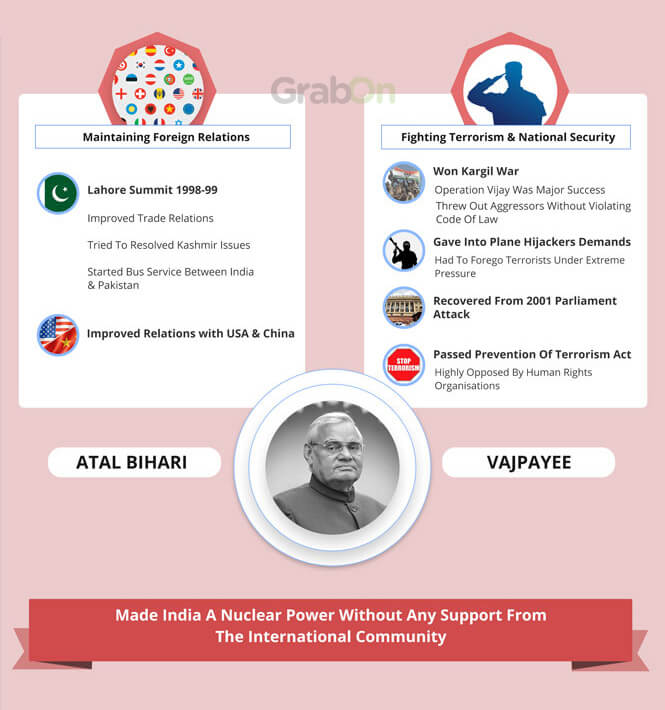
-
Pokhran-II Nuclear Tests
Declared India a nuclear state; 5 tests conducted, followed by a no-first-use pledge.
-
Golden Quadrilateral Highways
5,846 km of highways built, reducing travel time and boosting logistics.
-
Kargil War Leadership
India successfully evicted Pakistani infiltrators; 527 soldiers martyred.
-
Sarva Shiksha Abhiyan
Launched universal education drive; primary enrollment rose to 96%.
P.V Narasimha Rao
Tenure: 21st June 1991-16th May 1996
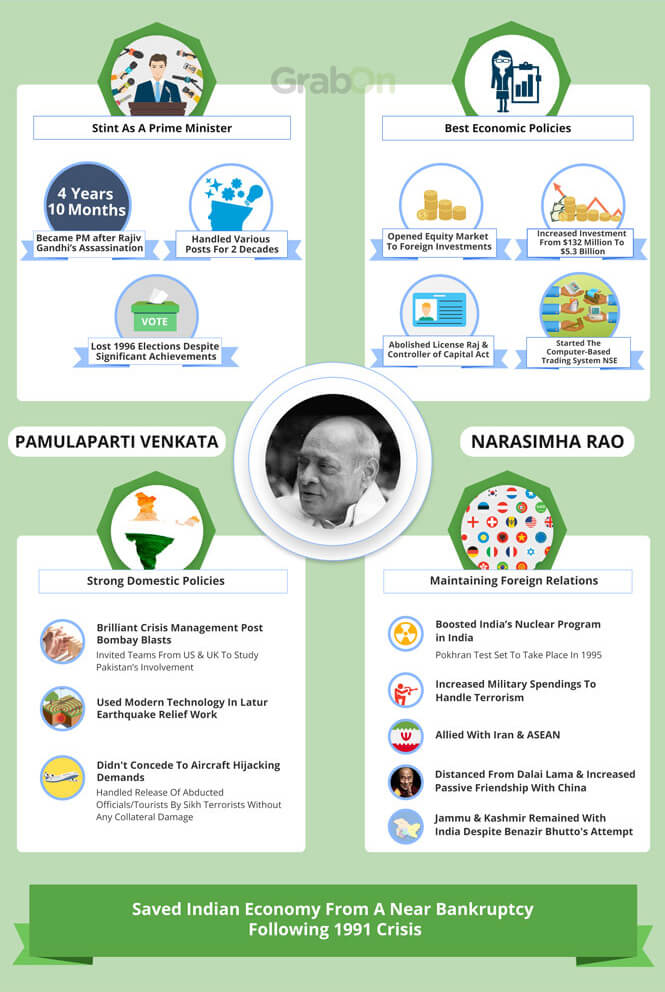
About P.V Narasimha Rao
Referred to as the Father of Indian Economic Reforms, Narasimha Rao was instrumental to India’s growth and globalisation. Before becoming the PM of India, he was the Chief Minister of Andhra Pradesh. He also held various portfolios in Andhra Pradesh’s cabinet and was responsible for major reforms in the state. Under his Prime Ministership, India experienced a shift in its economic model; going from a mixed economy to a market economy.
Place of Birth: Laknepally, Telangana
Qualification: Master’s degree in law, Hislop College
Some of his key achievements were:
-
1991 Economic Reforms
Ended License Raj, liberalized trade, allowed FDI, and devalued the rupee. GDP jumped from 1.1% to 7.3% in 3 years.
-
Panchayati Raj Amendments
The 73rd & 74th Amendments empowered 3M+ local reps, reserving 33% seats for women.
-
Look East & Israel Ties
Launched the Look East policy and established diplomatic ties with Israel.
Chandra Shekhar Singh
Tenure: 10th November 1990- 21st June 1991

About Chandra Shekhar Singh
The second shortest tenure after Mr. Charan Singh, Chandra Shekhar’s tenure lasted a little over 7 months. He was attracted to politics from a young age and was known for his revolutionary ideas revolving around the politics of social change. He also held the post of Minister of Home Affairs during his period in the office of Prime Minister. Due to the political instability at that point, he couldn’t contribute much.
Place of Birth: Ibrahimpatti
Qualification: Bachelor of Arts, Satish Chandra PG College and Master’s in political science, Allahabad University
Here are some of his key achievements.
-
Gold Pledge to Avert Default
Airlifted 47 tonnes of gold to secure emergency IMF loan. Reserves were at a 2-week import cover.
-
Reform Blueprint
Initiated stabilization steps that paved the way for 1991 liberalization.
Vishwanath Pratap Singh
Tenure: 2nd December 1989- 10th November 1990

About Vishwanath Pratap Singh
The 7th Prime Minister of India, Vishwanath Pratap Singh started his political journey at the age of 10. Before becoming the PM, he was the Chief Minister of Uttar Pradesh. He also held various portfolios in the union cabinet such as Minister of Commerce and Minister of Finance and Defence. Known for the implementation of the Mandal Commission, during his Prime Ministership, Mr V.P Singh’s short tenure of 11 months was full of interesting developments.
Place of Birth: Prayagraj
Qualification: B.Sc from University of Pune and B.A., L.L.B from Allahabad University
-
Mandal Commission Implementation
Granted 27% OBC job reservations, empowering 40% of the population.
-
Anti-Corruption Focus
Pushed the Bofors probe and enacted the Prevention of Corruption Act.
Rajiv Gandhi
Tenure: 31st October 1984- 2nd December 1989

About Rajiv Gandhi
Part of the Gandhi-Nehru family, Rajiv Gandhi was the son of Indira Gandhi. After his brother, Mr Sanjay Gandhi, died in an aeroplane crash, Rajiv Gandhi decided to enter politics. He was (and still is) the youngest person to hold the post of Prime Minister in India. Having acquired a commercial pilot’s license, Rajiv also worked for Indian Airlines. As a PM, he is often credited with contributing the most towards India’s IT revolution.
Place of Birth: Mumbai, Maharashtra
Qualification: B.Tech, Trinity College (dropped out)
Below are some of his key achievements.
-
Telecom & Computer Reforms
Set up C-DOT and liberalized IT imports, sparking a digital revolution.
-
Anti-Defection Law & Voting Age
Introduced the 52nd Amendment (anti-defection) and lowered the voting age to 18, adding ~35M new voters.
-
Assam & Punjab Peace Accords
Signed historic agreements reducing militancy and restoring state stability.
-
Early Economic Liberalization
Industrial licensing eased and tax rates cut, raising GDP growth to 5.5%.
Charan Singh
Tenure: 28th July 1979- 14th January 1980

About Charan Singh
Considered to be the champion of peasants, Chaudhary Charan Singh enjoyed a brief time in the office. A lawyer by profession, Singh served Uttar Pradesh in various capacities and was known for raising his voice against corruption, nepotism and inefficiency in the administrator. He is also the man behind major land reforms in UP. He was an avid reader and author of several books including ‘Abolition of Zamindari’.
Place of Birth: Hapur
Qualification: L.L.B and Master’s in Arts from Agra University
During his short tenure, he made the following key decisions.
-
Pro-Farmer Reforms
Architect of UP’s Zamindari Abolition Act. Focused on land reforms, rural investment, and farm support prices.
-
Cottage Industries & Rural Development
Backed rural industries and banking access, laying the groundwork for future rural empowerment.
Morarji Desai
Tenure: 24th March 1977- 28th July 1979
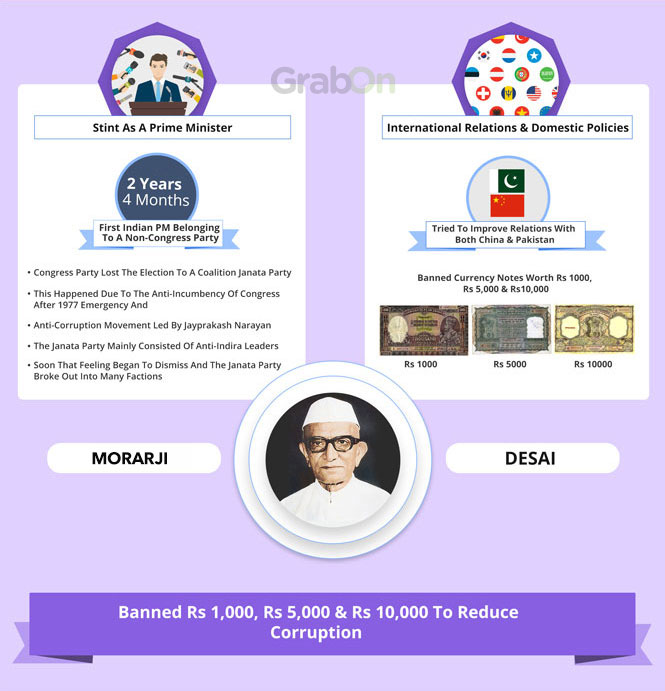
About Morarji Desai
The first Indian PM who was not from the Congress party, Morarji Desai was (and still is) the oldest person to hold the Prime Minister’s office. A renowned independence activist, Desai led the government formed by the Janata Party. Before serving as the PM, he was the 2nd Chief Minister of Bombay State from 1952 to 1956.
Place of Birth: Valsad
Qualification: Graduated from Wilson College, Mumbai
In his two years in office as India’s Prime Minister, he brought about some major reforms.
-
Shah Commission Inquiry
Investigated Emergency abuses, restoring democratic institutions.
-
Diplomatic Outreach
First Indian PM to visit Pakistan and normalize ties with China post-1962.
-
Nuclear Restraint
Maintained a moratorium on nuclear weapons development, advocating disarmament.
Indira Gandhi
Tenure: 24th January 1966 to 24 March 1977; 14th January 1980 to 31st October 1984
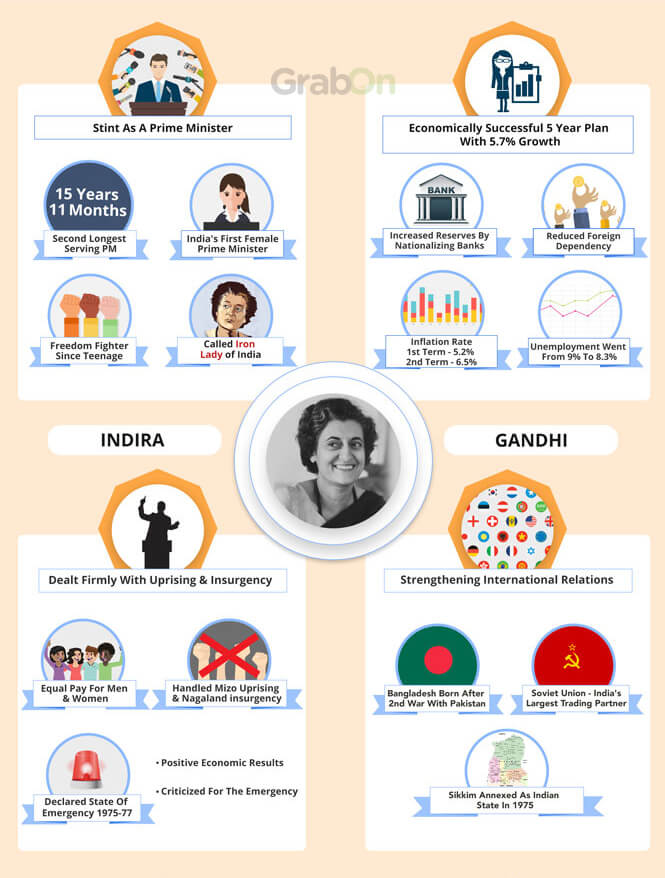
About Indira Gandhi
Known as the Iron Lady of India, Indira Gandhi is the only female Prime Minister of India. Before becoming the Prime Minister, she served as the Minister of Information and Broadcasting from 1964 to 1966. Besides serving as the PM of India, she concurrently held various portfolios including Minister of Atomic Energy, Minister of Home Affairs and Minister of External Affairs. A central figure in Indian politics, Indira Gandhi brought in a lot of changes.
Place of Birth: Prayagraj
Qualification: Visva-Bharati University (dropped out) and Somerville College, Oxford (dropped out)
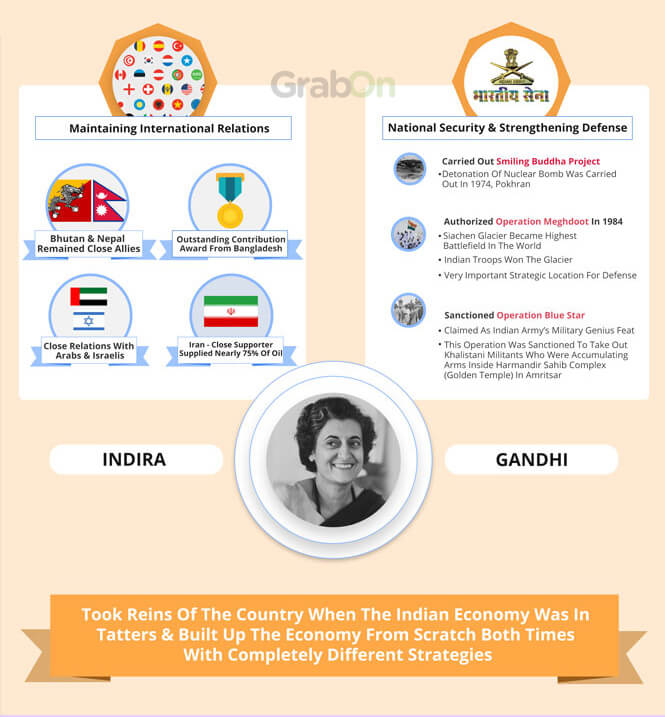
Her key achievements are:
-
Bank Nationalization (1969)
14 banks were nationalized, expanding credit access in rural areas. Agriculture loans rose from 2% to 13% by 1973.
-
1971 War & Bangladesh Liberation
Led India to victory, resulting in Bangladesh’s creation and 93,000 Pakistani POWs—the largest surrender since WWII.
-
Pokhran-I Nuclear Test (1974)
India’s first nuclear test made it the 6th nation with nuclear capability.
-
Emergency (1975–77)
Suspended democracy and jailed over 140,000 people. Later led to constitutional limits on emergency powers.
Lal Bahadur Shastri
Tenure: 9th June 1964 to 11th Jan 1966

About Lal Bahadur Shastri
Considered to be a leader of the masses, Lal Bahadur Shastri also served as the Railway Minister and Home Minister. In his two-year tenure, before his tragic death, he brought in some key achievements. His famous slogan ‘Jai Jawan, Jai Kisan’ during the 1965 Indo-Pakistan to cheer the soldiers and farmers was extremely popular.
Place of Birth: Mughalsarai
Qualification: Bachelor’s in philosophy and ethics, Vidyapith
His achievements include:
-
Green Revolution Kickstart
Faced with food shortages, Shastri promoted high-yield seeds and irrigation. Wheat output rose from 12M tons (1965) to 20M by 1970.
-
Dairy Sector Boost
Founded NDDB in 1965, laying the groundwork for Operation Flood. India became the world’s top milk producer by the 1990s.
-
1965 War Leadership
Successfully defended India in the 1965 war with Pakistan and signed the Tashkent Agreement.
Gulzarilal Nanda
Tenure: 27th May 1964 to 9th June 1964; 11th January to 24th January 1966
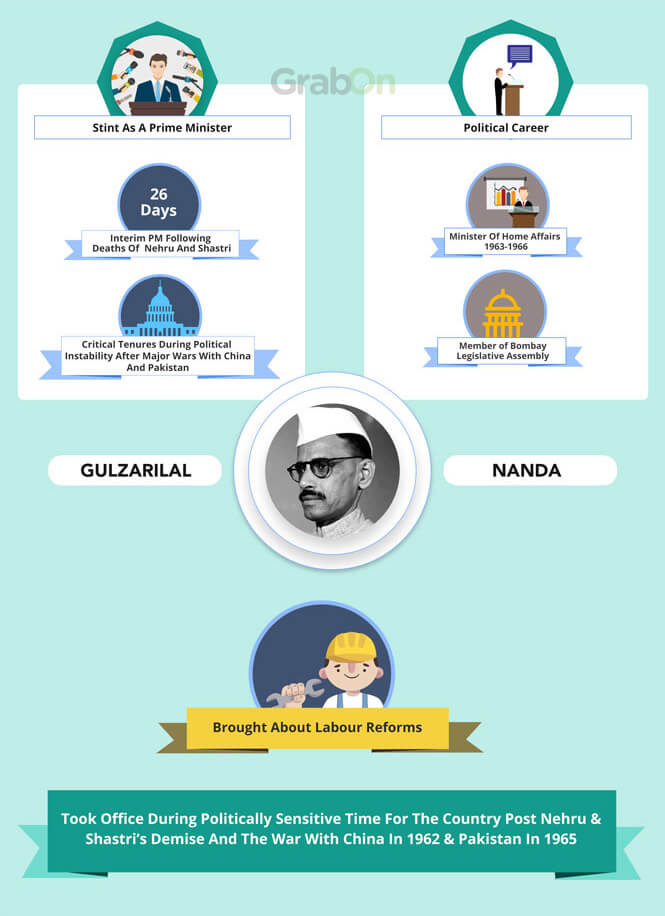
About Gulzarilal Nanda
Serving as the acting Prime Minister after the death of Pt. Jawaharlal Nehru, Mr Nanda served the office for two months. Apart from being a politician, he was an economist who worked as a research scholar on labour issues. He also held the post of Union Minister for Labour and Employment. In his brief tenure, he did not sit quietly. Instead, he brought about numerous changes. Later, he was again appointed as the acting Prime Minister after the death of Lal Bahadur Shastri for 13 days.
Place of Birth: Sialkot, Pakistan
Qualification: Studies in Lahore, Agra and Allahabad. Research scholar on labour problems, University of Allahabad
His achievements include:
-
Leadership During Crisis
Steered India through turbulent transitions as interim PM after the 1964 and 1966 deaths of Jawaharlal Nehru and Lal Bahadur Shastri. He ensured stability after the 1962 Indo-China and 1965 Indo-Pak wars.
-
Labour Reforms Initiated
Pioneered modern labor policies as Union Labour Minister and improved industrial relations, strengthened trade unions, and pushed for fair wages and worker rights.
Jawaharlal Nehru
Tenure: 15th August 1947 to 27th May 1964
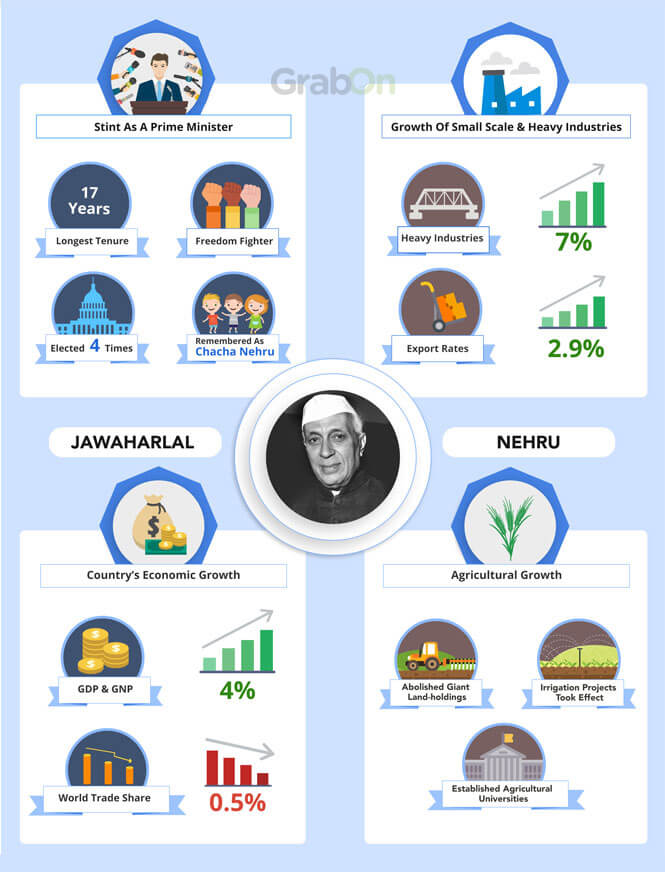
About Jawaharlal Nehru:
The longest-serving Prime Minister, Chacha Nehru (as he is fondly remembered) was a central figure in Indian politics, both before and after independence. Born on 14 November 1889, his significant focus was to enhance the country’s industrial sector for which he started the ‘five-year plan in 1951′.
Place of Birth: Prayagraj
Qualification: Graduated with an honours degree in natural science, from Trinity College
Besides his famous non-aligned policies in foreign affairs, his other key achievements are:
-
Non-Alignment in Foreign Policy
Nehru founded the Non-Aligned Movement (NAM) in 1961, allowing India to stay neutral during the Cold War. NAM grew to 121 members, representing two-thirds of UN members and over half of the global population.
-
Five-Year Plans & Industrialization
Nehru launched state-led development with the First Five-Year Plan (1951–56), achieving 3.6% GDP growth (vs 2.1% projected). He established major dams and IITs, and the Second Plan focused on heavy industry with steel plants like Bhilai and Durgapur.
-
States Reorganisation Act (1956)
Nehru redrew state boundaries based on languages, forming 14 states and 6 union territories. This balanced national unity with linguistic diversity.

The list can go on. Considering he was India’s first Prime Minister and served for 17 years, it is hardly a surprise.
So, that’s the country’s history. How well do you know the leaders who shaped our country?




